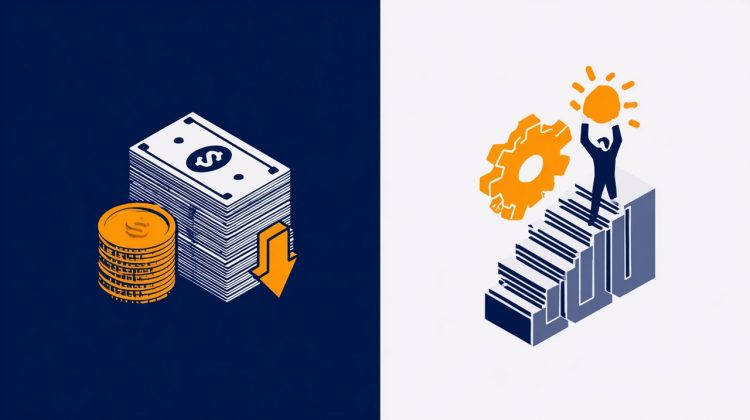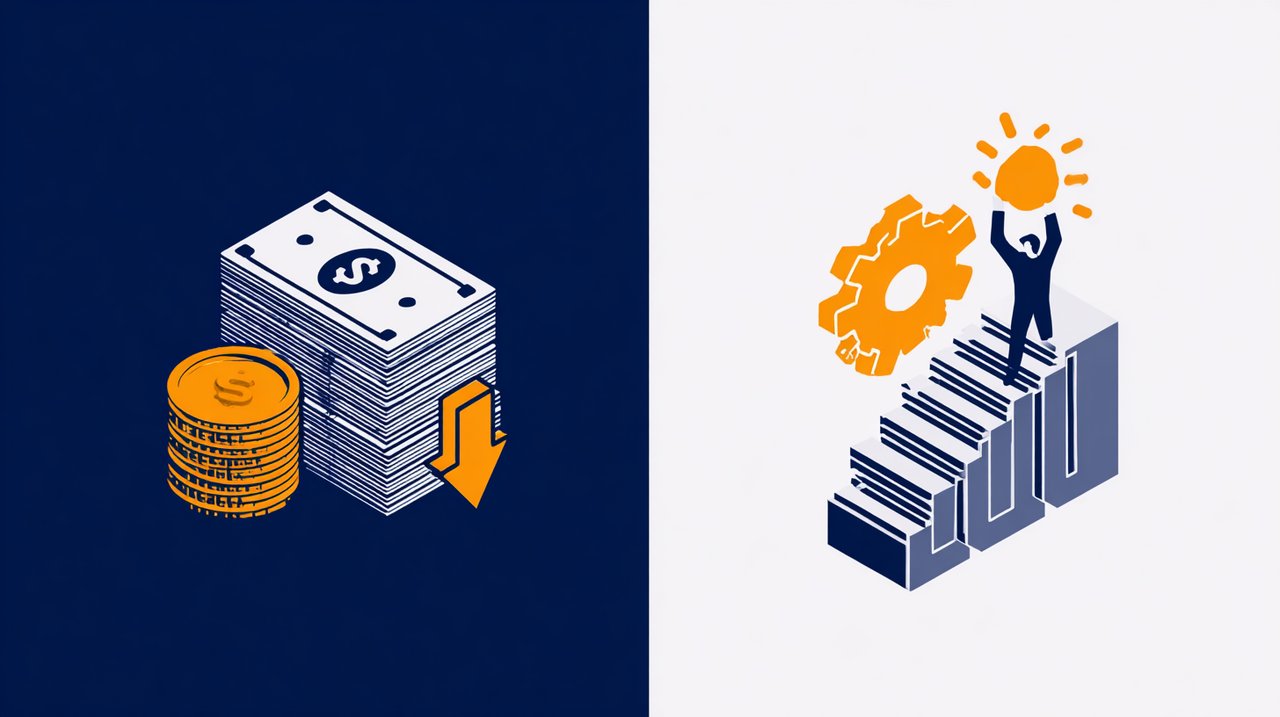Most people carry debt, but few know the fastest way out. The average American household, for instance, grapples with over $100,000 in debt, excluding mortgages. This isn’t just a number; it’s a drag on financial potential, a constant drain on resources that could be fueling growth or security.
Today, we’re cutting to the chase on the ultimate debt repayment showdown: Debt Avalanche vs. Debt Snowball: Which Works Faster? As your go-to efficiency hacker, I’ve seen countless strategies. We’ll strip away the fluff and look at what truly performs in the real world.

Strategy Fundamentals: Avalanche and Snowball
Before we pit these two head-to-head, let’s establish their core mechanics. Both are systematic approaches to debt repayment, designed to provide structure and momentum. However, their underlying logic couldn’t be more different.
Debt Avalanche: The Math-Driven Approach
The debt avalanche method for paying off credit cards and other high-interest debts is pure, unadulterated financial logic. It prioritizes saving money on interest.
- Methodology: You list all your debts from the highest interest rate to the lowest. You pay the minimum on all debts except the one with the highest interest rate, on which you throw every extra dollar you have. Once that debt is paid off, you take the money you were paying on it (minimum + extra) and apply it to the next debt on your list with the highest interest rate.
- Core Benefit: Minimizes the total interest paid over the life of your debt. This translates directly into less money out of your pocket and a faster overall payoff in terms of pure financial metrics.
Consider this: A credit card with 20% APR costs you significantly more each month than a student loan at 6%. The Avalanche method targets that 20% first, stopping the bleeding where it’s worst.
Debt Snowball: The Behavioral Boost
In contrast, the Debt Snowball method is less about the math and more about human psychology. It’s designed to build momentum and keep you motivated.
- Methodology: You list all your debts from the smallest balance to the largest, regardless of interest rate. You pay the minimum on all debts except the one with the smallest balance, on which you throw every extra dollar you have. Once that smallest debt is paid off, you take the money you were paying on it (minimum + extra) and apply it to the next smallest debt.
- Core Benefit: Provides quick wins. Paying off a small debt completely gives a powerful psychological boost, encouraging you to stick with the plan. This method is championed for its ability to sustain motivation through early successes.
Imagine clearing a $500 medical bill in a month. That feeling of accomplishment can be a potent fuel for tackling larger, more daunting debts.
Performance Metrics: Speed, Savings, Psychology

When we ask Debt Avalanche vs. Debt Snowball: Which Works Faster?, we need to define “faster.” Is it about time, or is it about the total cost? And what role does human nature play in sticking to the plan?
Time and Total Cost: The Data Speaks
From a purely mathematical standpoint, the Debt Avalanche method consistently works faster and saves more money. This isn’t a debate; it’s a fact proven by algorithms and spreadsheets.
The Debt Avalanche strategy, by targeting high-interest debt first, always results in less interest paid and a shorter overall repayment period, assuming consistent payments.
- Interest Savings: Avalanche wins every time. By eliminating high-interest debt first, you stop the compounding effect of expensive interest charges sooner. This means more of your payment goes towards principal, accelerating your debt-free date.
- Repayment Duration: Avalanche generally wins here too. Less interest means less to pay overall, which translates to a shorter timeline if your payment amount remains constant. Think of it as plugging the biggest leak in a bucket first; the bucket empties faster.
For families considering which debt repayment strategy works faster for families based on raw numbers, Avalanche is the clear victor. A typical debt snowball vs avalanche comparison guide will show a significant difference in total interest paid, often thousands of dollars over just a few years.
The Human Element: Motivation and Adherence
Here’s where the Snowball method shines, and where the “faster” question gets complicated. While Avalanche is mathematically superior, it demands more discipline.
- Psychological Impact: The Snowball method’s power lies in its ability to provide immediate gratification. Those early, quick wins can be crucial for individuals or families who feel overwhelmed by debt. Seeing debts disappear, even small ones, builds confidence and reinforces positive financial behavior.
- Adherence Rates: Some studies suggest that people are more likely to stick with the Debt Snowball method because of these psychological boosts. A strategy, no matter how mathematically perfect, is useless if you abandon it.
For some, the “fastest” strategy isn’t the one that saves the most money on paper, but the one they can actually stick to until the end. If the psychological wins keep you in the game, the Snowball could, in a practical sense, lead to a faster payoff for you.
Real-World Application: Choosing Your Path
Max Pan’s rule: The best tool is the one you’ll actually use effectively. Choosing between Debt Avalanche vs. Debt Snowball: Which Works Faster? isn’t just about crunching numbers; it’s about knowing yourself and your household’s financial personality.
Self-Assessment: Know Your Debt Profile and Mindset
Before committing, take a hard look at your situation:
- Debt Structure: Are your highest interest rates on small balances or large ones? Do you have many small debts that could be quickly eliminated?
- Financial Discipline: Are you someone who can stick to a long-term plan without immediate gratification? Or do you need frequent wins to stay motivated?
- Income Stability: How predictable is your income? Can you consistently make extra payments?
If you’re a numbers person, highly disciplined, and your highest interest debts are significant, the Avalanche is your tool. If you’ve struggled with debt repayment before, feel easily discouraged, or have several small debts, the Snowball might be the psychological hack you need.
Execution Blueprint: Implementing Your Chosen Strategy
Once you’ve made your choice, consistent execution is paramount. Here’s a practical blueprint:
- Inventory All Debts: List every debt, including the creditor, current balance, minimum payment, and interest rate. Organize them according to your chosen method (highest interest for Avalanche, smallest balance for Snowball).
- Automate Minimums: Set up automatic payments for the minimum amount on all debts. This prevents late fees and protects your credit score.
- Allocate Extra Funds: Direct every available extra dollar to your target debt. This requires budgeting and potentially cutting discretionary spending.
- Roll Over Payments: When a debt is paid off, immediately reallocate its entire previous payment (minimum + extra) to the next debt on your list. This is the “snowball” effect, regardless of the method.
Pro Tip: Use a digital tracking tool. Spreadsheets work, but dedicated debt payoff apps can visualize your progress, showing you exactly how much interest you’re saving or how many debts you’ve crushed. Seeing that progress bar fill up is a game-changer for motivation.
Ultimately, the “faster” strategy is the one you can commit to and execute without fail. For some, that’s the mathematically superior Avalanche. For others, it’s the psychologically reinforcing Snowball. The real win is becoming debt-free.
Ready to take control of your finances? Explore advanced budgeting tools and automated savings platforms designed to supercharge your chosen debt repayment strategy, and discover even more practical tips to achieve financial freedom 10 Tips to Get Out of Debt: Your Practical Guide to Financial Freedom.
Debt Repayment Strategy Comparator
💡 Frequently Asked Questions
The article primarily discusses two systematic debt repayment strategies: the Debt Avalanche method and the Debt Snowball method.
The Debt Avalanche method involves listing all your debts from the highest interest rate to the lowest. You pay the minimum on all debts except the one with the highest interest rate, on which you throw every extra dollar. Its main advantage is minimizing the total interest paid over the life of your debt, leading to a faster overall payoff in terms of pure financial metrics.
The Debt Snowball method involves listing all your debts from the smallest balance to the largest, regardless of interest rate. You pay the minimum on all debts except the one with the smallest balance, on which you throw every extra dollar. Its main advantage is providing quick wins and psychological boosts, which helps build momentum and keep you motivated to stick with the plan.
From a purely mathematical standpoint, the Debt Avalanche method consistently works faster and saves more money. By targeting high-interest debt first, it results in less interest paid and a shorter overall repayment period, assuming consistent payments.
Choosing between the methods depends on your personal financial personality and discipline. If you are a numbers person, highly disciplined, and your highest interest debts are significant, the Avalanche method is recommended. If you've struggled with debt repayment before, feel easily discouraged, or have several small debts, the Snowball method might be more effective due to its psychological benefits and ability to sustain motivation.








